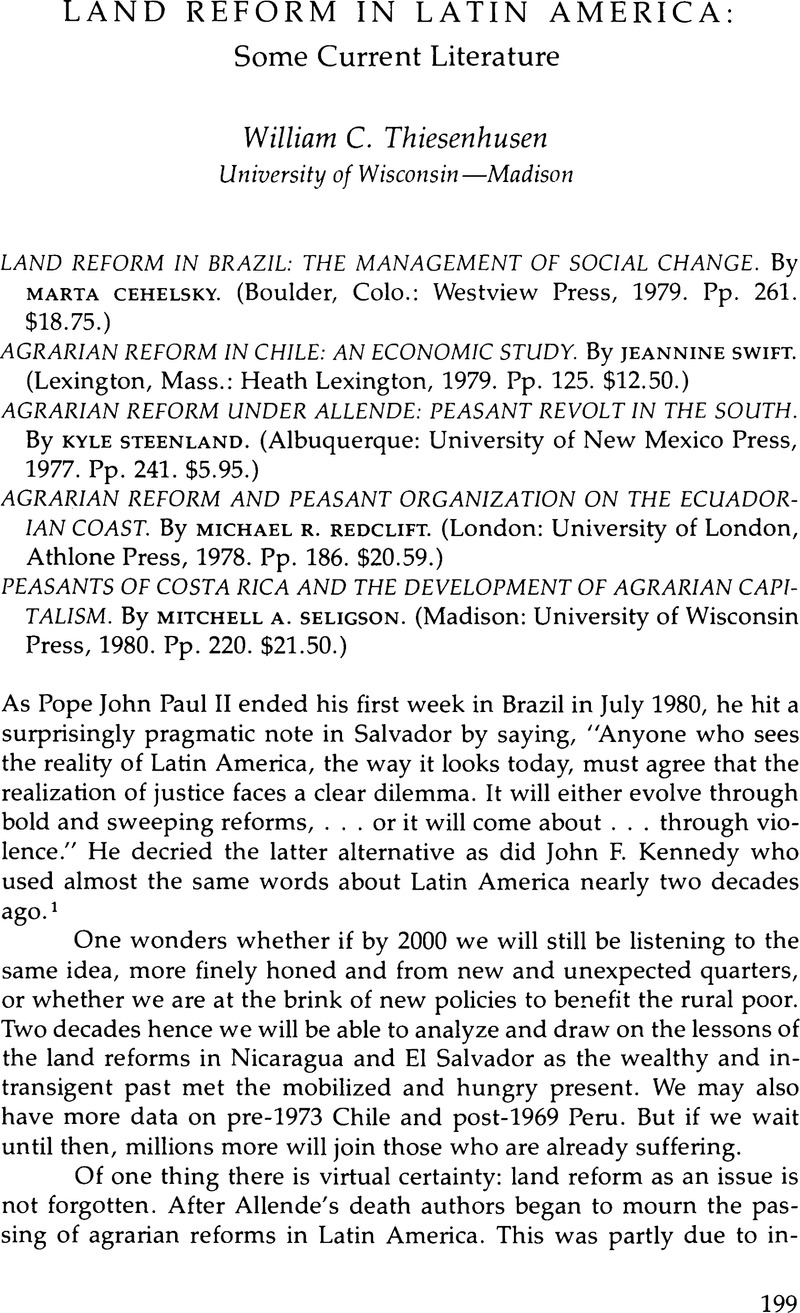Published online by Cambridge University Press: 24 October 2022

1. New York Times, 7 July 1980. He used the same phraseology in São Paulo. See New York Times, 4 July 1980.
2. Merilee S. Grindle, “Whatever Happened to Agrarian Reform: The Latin American Experience.” Mimeographed. Wellesley, Mass.: Wellesley College.
3. Jaime Wheelock, Versión estenográfica de la conferencia de prensa (Managua: Ministerio de Agricultura, 17 de julio de 1980), p. 1 (my translation).
4. Ibid., Part 2, p. 4.
5. Ibid., Part 3, p. 4.
6. Rafael M. Salas, The State of World Population, 1980 (New York: U.N. Fund for Population Activities, 16 June 1980). See also U.S. News and World Report, 18 August 1980.
7. Food and Agriculture Organization of the United Nations, Report of the World Conference on Agrarian Reform and Rural Development, WCARRD/Rep. (Rome: FAO, July 1979), p. 1.
8. Food and Agriculture Organization, “Analysis of Changes in the Draft Declaration of Principles and Programme of Action as Reflected in the Final Report.” Mimeographed. Rome, August 1979.
9. One excellent but brief example of what is needed is Cristóbal Kay, “The Development of the Chilean Hacienda System, 1850–1973,” in Land and Labour in Latin America, by Kenneth Duncan and Ian Rutledge (Cambridge, Eng.: Cambridge University Press, 1977), pp. 103–39.
10. “These reforms induce a transition from precapitalist to capitalist agriculture either by threats of expropriation if land remains underutilized or by making semifeudal social relations illegal. … A reform sector is created, and the precapitalist latifundio is thus transformed into a large-scale, capitalist (‘junker‘) enterprise hiring wage laborers—often semiproletarians. The landed elite retains control of the state and … archaic land tenure is eliminated. The 1964 reform in Ecuador similarly proscribed huasipungaje (labor services in exchange for usufruct of land) and titled the plots to occupants.” Alain de Janvry and Lynn Ground, “Types and Consequences of Land Reform in Latin America,” Latin American Perspectives 5:4 (Fall 1978), p. 94. But illustrating the difficulty of such classification, de Janvry and Ground also include, as part of their definition, the proviso that “the internal subsistence economy is eliminated.” That did not happen in Ecuador. Indeed it has been argued by others that the minifundismo created by the abolition of the huasipungo system was as bad or worse than huasipungaje itself. And they do not include the issue around which Redclift organizes his book: the abolition of tenancy relations (precarismo) among Ecuadorian coastal rice producers as a result of Decree 1001 in 1970.
11. Colonization in the West as part of the 1964 land reform is not included. For this, see Franz J. Schuurman, “Colonization Policy and Peasant Economy in the Amazon Basin,” Boletín de Estudios Latinoamericanos y del Caribe, no. 27 (diciembre de 1979), pp. 29–41.
12. The yield (in metric tons) of rice in Ecuador was 164 per year from 1961 to 1965; from 1969–71 it was 165. In 1977 it was 328; in 1978, 225; and in 1979 it was estimated at 300. Food and Agriculture Organization of the United Nations, Production Yearbook, 1976 (Rome: FAO), p. 94, table 11; and FAO Monthly Bulletin of Statistics 3:1 (January 1980), table 6.
13. This primacy of AID over campesino organizations is disputed in the brief review of the book by Luzuriaga C. and Zuvekas: “In commenting on Redclift's study we may note, first, that AID's involvement in agrarian reform was not based on production considerations alone. Distributional objectives were equally important, if not more so. Second, Redclift assumes the Ecuadorian state to be more powerful, monolithic, and calculating than we believe is warranted. Third, it is curious that Redclift is critical of the government's credit and marketing policies—which he views as mechanisms for exercising control over small rice producers, particularly since (1) most observers have regarded these policies as favorable to the small producer and (2) these policies seem inconsistent with a desire to restrict the cost of urban wage goods, which Redclift argues was part of the government's grand strategy. Fourth, we believe that government agrarian reform efforts in the Guayas Basin were in part a response to campesino pressures.” Carlos Luzuriaga C. and Clarence Zuvekas, “Income Distribution and Poverty in Rural Ecuador: A Survey of the Literature 1950–1979,” General Working Document no. 2. Mimeographed. Quito, June 1980, pp. 224–25.
14. See especially Samuel P. Huntington, Political Order in Changing Societies (New Haven, Conn.: Yale University Press, 1968). Many case studies corroborate this idea.